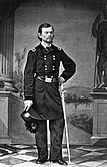|
Hardee hat The Hardee hat, also known as the Model 1858 Dress Hat and sometimes nicknamed the "Jeff Davis", was the regulation dress hat for enlisted men in the Union Army during the American Civil War. The Hardee hat was also worn by Confederate soldiers.[1][2] HistoryOriginThe Hardee hat was first worn by the 1st and 2nd U.S. Cavalry Regiments when raised in 1855. The issue of this new headdress to these units as a substitute for the shakos and forage caps worn by the remainder of the army was initially a provisional one inspired by then Major William J. Hardee of the 2nd Cavalry (see below).[3] UsageDuring the Civil War most soldiers found the black felt hat to be too hot and heavy and shunned its use, preferring a forage cap or slouch hat.[citation needed] The unadorned, plain and often field-modified Hardee hat was, however, worn by Union troops, especially in the Western theater. The Hardee hat was most famously worn, and easily identified, as the hat worn by the Union Army's Iron Brigade, and it became their trademark and they were popularly known by the nickname "The Black Hats". William J. HardeeThe hat was named after William J. Hardee, a career officer in the U.S. Army from 1838 until resigning his commission on January 31, 1861. Hardee was Commandant of Cadets at West Point from 1856 to 1860. He was lieutenant colonel of the 1st U.S. Cavalry until just before the war. In 1855, he published Rifle and Light Infantry Tactics for the Exercise and Manoeuvres of Troops When Acting as Light Infantry or Riflemen,[4] popularly known as Hardee's Tactics, which became the best-known drill manual of both sides of the Civil War. He joined the Confederate States Army in March 1861 and eventually became a lieutenant general and corps commander. RegulationsU.S. Army regulations specified that the hat should be adorned with a brass hat device and a wool hat cord denoting the branch of service of the wearer: sky blue for infantry, scarlet for artillery, and gold for cavalry. The brim was to be pinned up on the right side for cavalrymen and artillerymen, and on the left for infantry soldiers.[5]
References
External links |




